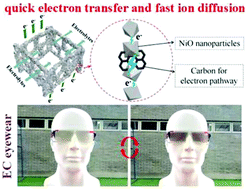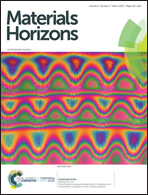Regulation of carbon content in MOF-derived hierarchical-porous NiO@C films for high-performance electrochromism†
Abstract
Nickel oxide (NiO) is a promising candidate in practical electrochromic (EC) applications owing to its low cost and neutral colored state. However, the co-influence of low electrical conductivity and small lattice spacing leads to the slow switching speed and poor coloration efficiency of NiO-based EC electrodes. In this study, novel hierarchical-porous NiO@C thin film electrodes are fabricated through two-step pyrolysis of Ni-MOF on FTO glass, and the electrochemical and electrochromic performance of the electrodes can be improved by the regulation of the carbon residues. As a result, the desired NiO@C EC electrodes with both good ion diffusion and electrical conductivity are achieved. The film electrode shows a fast switching speed (0.46 s for coloring/0.25 s for bleaching), high coloration efficiency (113.5 cm2 C−1) and ultra-stable EC cycles (90.1% after 20 000 cycles). Additionally, EC eyewear devices and digital displays are assembled to illustrate the feasibility of the material in wearable devices and smart electronics.



 Please wait while we load your content...
Please wait while we load your content...